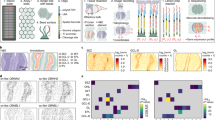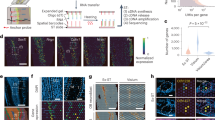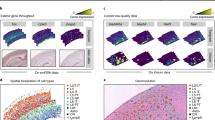Abstract
Several techniques are currently being developed for spatially resolved omics profiling, but each new method requires the setup of specific detection strategies or specialized instrumentation. Here we describe an imaging-free framework to localize high-throughput readouts within a tissue by cutting the sample into thin strips in a way that allows subsequent image reconstruction. We implemented this framework to transform a low-input RNA sequencing protocol into an imaging-free spatial transcriptomics technique (called STRP-seq) and validated it by profiling the spatial transcriptome of the mouse brain. We applied the technique to the brain of the Australian bearded dragon, Pogona vitticeps. Our results reveal the molecular anatomy of the telencephalon of this lizard, providing evidence for a marked regionalization of the reptilian pallium and subpallium. We expect that STRP-seq can be used to derive spatially resolved data from a range of other omics techniques.
This is a preview of subscription content, access via your institution
Access options
Access Nature and 54 other Nature Portfolio journals
Get Nature+, our best-value online-access subscription
$29.99 / 30 days
cancel any time
Subscribe to this journal
Receive 12 print issues and online access
$209.00 per year
only $17.42 per issue
Buy this article
- Purchase on Springer Link
- Instant access to full article PDF
Prices may be subject to local taxes which are calculated during checkout





Similar content being viewed by others
Data availability
RNA-seq data are available at the Gene Expression Omnibus repository (https://www.ncbi.nlm.nih.gov/geo) under accession GSE152989. Results of the reconstruction can be accessed at this paper’s companion website: https://strpseq-viewer.epfl.ch/.
Code availability
Source code and templates for customized 3D-printable cryosectioning adaptor manifolds are available at https://github.com/lamanno-epfl/tomographer.
References
Lein, E. S. et al. Genome-wide atlas of gene expression in the adult mouse brain. Nature 445, 168–176 (2007).
Goldman, S. L. et al. The impact of heterogeneity on single-cell sequencing. Front. Genet. 10, 1–8 (2019).
Haque, A., Engel, J., Teichmann, S. A. & Lönnberg, T. A practical guide to single-cell RNA-sequencing for biomedical research and clinical applications. Genome Med. 9, 1–12 (2017).
Lein, E., Borm, L. E. & Linnarsson, S. The promise of spatial transcriptomics for neuroscience in the era of molecular cell typing. Science 358, 64–69 (2017).
Linnarsson, S. & Teichmann, S. A. Single-cell genomics: coming of age. Genome Biol. 17, 16–18 (2016).
Tasic, B. et al. Adult mouse cortical cell taxonomy revealed by single cell transcriptomics. Nat. Neurosci. 19, 335–346 (2016).
E. Berglund et al. Spatial maps of prostate cancer transcriptomes reveal an unexplored landscape of heterogeneity. Nat. Commun. 9, 2419 (2018).
Chen, K. H., Boettiger, A. N., Moffitt, J. R., Wang, S. & Zhuang, X. Spatially resolved, highly multiplexed RNA profiling in single cells. Science 348, 1360–1363 (2015).
Zhu, Q., Shah, S., Dries, R., Cai, L. & Yuan, G. C. Identification of spatially associated subpopulations by combining scRNAseq and sequential fluorescence in situ hybridization data. Nat. Biotechnol. 36, 1183–1190 (2018).
Codeluppi, S. et al. Spatial organization of the somatosensory cortex revealed by osmFISH. Nat. Methods 15, 932–935 (2018).
Eng, C. H. L. et al. Transcriptome-scale super-resolved imaging in tissues by RNA seqFISH. Nature 568, 235–239 (2019).
Ke, R. et al. In situ sequencing for RNA analysis in preserved tissue and cells. Nat. Methods 10, 857–860 (2013).
Rodriques, S. G. et al. Slide-seq: a scalable technology for measuring genome-wide expression at high spatial resolution. Science 363, 1463–1467 (2019).
Salmén, F. et al. Barcoded solid-phase RNA capture for spatial transcriptomics profiling in mammalian tissue sections. Nat. Protoc. 13, 2501–2534 (2018).
Shah, S. et al. Dynamics and spatial genomics of the nascent transcriptome by intron seqFISH. Cell 174, 363–376 (2018).
Vickovic, S. et al. High-definition spatial transcriptomics for in situ tissue profiling. Nat. Methods 16, 987–990 (2019).
Wang, G., Moffitt, J. R. & Zhuang, X. Multiplexed imaging of high-density libraries of RNAs with MERFISH and expansion microscopy. Sci. Rep. 8, 1–13 (2018).
Zechel, S., Zajac, P., Lönnerberg, P., Ibáñez, C. F. & Linnarsson, S. Topographical transcriptome mapping of the mouse medial ganglionic eminence by spatially resolved RNA-seq. Genome Biol. 15, 486 (2014).
Moor, A. E. et al. Spatial reconstruction of single enterocytes uncovers broad zonation along the intestinal villus axis. Cell 175, 1156–1167 (2018).
Junker, J. P. et al. Genome-wide RNA tomography in the zebrafish embryo. Cell 159, 662–675 (2014).
Kruse, F., Junker, J. P., van Oudenaarden, A. & Bakkers, J. Tomo-seq: a method to obtain genome-wide expression data with spatial resolution. Methods Cell Biol. 135, 299–307 (2016).
Ebbing, A. et al. Spatial transcriptomics of C. elegans males and hermaphrodites identifies sex-specific differences in gene expression patterns. Dev. Cell 47, 801–813 (2018).
Lacraz, G. P. A. et al. Tomo-seq identifies SOX9 as a key regulator of cardiac fibrosis during ischemic injury. Circulation 136, 1396–1409 (2017).
Wu, C. C. et al. Spatially resolved genome-wide transcriptional profiling identifies BMP signaling as essential regulator of zebrafish cardiomyocyte regeneration. Dev. Cell 36, 36–49 (2016).
Kaya, I. et al. Spatial lipidomics reveals region and long chain base specific accumulations of monosialogangliosides in amyloid plaques in familial Alzheimer’s disease mice (5xFAD) brain. ACS Chem. Neurosci. 11, 14–24 (2020). Jan.
Lundberg, E. & Borner, G. H. H. Spatial proteomics: a powerful discovery tool for cell biology. Nat. Rev. Mol. Cell Biol. 20, 285–302 (2019). May.
Donoho, D. L. Compressed sensing. IEEE Trans. Inf. Theory 52, 1289–1306 (2006).
Cierniak, R. & Cierniak, R. Reconstruction from parallel-beam projections. In: X-Ray Computed Tomography in Biomedical Engineering 83–125 (Springer, 2011).
Herman, G. T. & Naparstek, A. Fast image reconstruction based on a radon inversion formula appropriate for rapidly collected data. SIAM J. Appl. Math. 33, 511–533 (1977).
Islam, S. et al. Quantitative single-cell RNA-seq with unique molecular identifiers. Nat. Methods 11, 163–166 (2014).
Anders, S. & Huber, W. Differential expression analysis for sequence count data. Genome Biol. 11, R106 (2010). Oct.
Grün, D., Kester, L. & Van, A. Oudenaarden, validation of noise models for single-cell transcriptomics. Nat. Methods 11, 637–640 (2014).
Tomassy, G. S. et al. Area-specific temporal control of corticospinal motor neuron differentiation by COUP-TFI. Proc. Natl Acad. Sci. USA 107, 3576–3581 (2010).
Weed, N. et al. Identification of genetic markers for cortical areas using a random forest classification routine and the Allen Mouse Brain Atlas. PLoS ONE 14, e0212898 (2019).
Hawrylycz, M. et al. Areal and laminar differentiation in the mouse neocortex using large scale gene expression data. Methods 50, 113–121 (2010).
Van Waes, V., Tseng, K. Y. & Steiner, H. GPR88: a putative signaling molecule predominantly expressed in the striatum: cellular localization and developmental regulation. Basal Ganglia 1, 83–89 (2011).
Lipiec, M. A. et al. TCF7L2 regulates postmitotic differentiation programmes and excitability patterns in the thalamus. Development 147, dev190181 (2020).
Gainer, H. Cell-specific gene expression in oxytocin and vasopressin magnocellular neurons. In: Zingg, H. H., Bourque, C. W. & Bichet, D. G. (eds) Vasopressin and Oxytocin. Advances in Experimental Medicine and Biology 15–27 (Springer, 1989).
Tanaka, K. F., Samuels, B. A. & Hen, R. Serotonin receptor expression along the dorsal−ventral axis of mouse hippocampus. Philos. Trans. R. Soc. B Biol. Sci. 367, 2395–2401 (2012).
Zeisel, A. et al. Cell types in the mouse cortex and hippocampus revealed by single-cell RNA-seq. Science 347, 1138–1142 (2015).
Hoops, D. et al. A 3D MRI-based atlas of a lizard brain. J. Comp. Neurol. 526, 2511–2547 (2018).
Tosches, M. A. et al. Evolution of pallium, hippocampus, and cortical cell types revealed by single-cell transcriptomics in reptiles. Science 360, 881–888 (2018).
Georges, A. et al. High-coverage sequencing and annotated assembly of the genome of the Australian dragon lizard Pogona vitticeps. Gigascience 4, 45 (2015).
Norimoto, H. et al. A claustrum in reptiles and its role in slow-wave sleep. Nature 578, 413–418 (2020).
Tsafrir, D., Tsafrir, I., Zuk, O., Notterman, D. A. & Domany, E. Sorting points into neighborhoods (SPIN): data analysis and visualization by ordering distance matrices. Bioinformatics 21, 2301–2308 (2005).
Virolainen, S.-M., Achim, K., Peltopuro, P., Salminen, M. & Partanen, J. Transcriptional regulatory mechanisms underlying the GABAergic neuron fate in different diencephalic prosomeres. Development 139, 3795–3805 (2012).
Bell, S. et al. Disruption of GRIN2B impairs differentiation in human neurons. Stem Cell Rep. 11, 183–196 (2018).
Garcia-Sevilla, J. A., Magnusson, T., Carlsson, A., Leban, J. & Folkers, K. Neurotensin and its amide analogue [Gln4]-neurotensin: effects on brain monoamine turnover. Naunyn Schmiedebergs Arch. Pharmacol. 305, 213–218 (1978).
Kuenzel, W. J., Medina, L., Csillag, A., Perkel, D. J. & Reiner, A. The avian subpallium: new insights into structural and functional subdivisions occupying the lateral subpallial wall and their embryological origins. Brain Res. 1424, 67–101 (2011).
Kaas, J. Evolution of Nervous Systems (Elsevier, 2016).
Wang, Q. et al. Organization of the connections between claustrum and cortex in the mouse. J. Comp. Neurol. 525, 1317–1346 (2017).
Striedter, G. F. Evolution of the hippocampus in reptiles and birds. J. Comp. Neurol. 524, 496–517 (2016).
Cembrowski, M. S., Wang, L., Sugino, K., Shields, B. C. & Spruston, N. Hipposeq: a comprehensive RNA-seq database of gene expression in hippocampal principal neurons. eLife 5, e14997 (2016).
Zeisel, A. et al. Molecular architecture of the mouse nervous system. Cell 174, 999–1014 (2018).
Kuchment, P. The Radon Transform and Medical Imaging (Society for Industrial and Applied Mathematics, 2013).
Okamura-Oho, Y. et al., Transcriptome tomography for brain analysis in the web-accessible anatomical space. PLoS ONE 7, e45373 (2012).
ten Donkelaar, H. J. & de Boer-van Huizen, R. Brain stem afferents to the anterior dorsal ventricular ridge in a lizard (Varanus exanthematicus). Anat. Embryol. 177, 465–475 (1988).
Vinciotti, V. et al. A differentiable alternative to the lasso penalty. Preprint at https://arxiv.org/abs/1609.04985 (2016).
Acknowledgements
We thank S. Linnarsson (Karolinska Insitutet) for allowing proof-of-principle tests in his laboratory; N. Shental, B. Shalem (Open University Israel) and A. Zeisel (Technion) for stimulating discussions; M. Schuelke (Charité) for enabling the participation of C.G.S. in this project; G. Laurent for discussion and providing samples; M. Weigert and L. Talamanca for discussing our formulation; A. Jacobi for contributing lizard in situ hybridizations; and P. Gönczy, B. Deplanke and F. Naef for constructive criticism of the manuscript. This work was supported by a grant from the Swiss National Science Foundation (CRSK-3_190495) to G.L.M. G.L.M. was also supported by CZI seed network grant HCA3-0000000081 and Swiss National Science Foundation grant PZ00P3_193445.
Author information
Authors and Affiliations
Contributions
G.L.M. conceived the study design and supervised the project. G.L.M., H.H.S. and C.G.S. analyzed, annotated and interpreted the tomography data and wrote the manuscript. M.A.T. and T.M.Y. performed P. vitticeps experiments and contributed to interpreting the results. G.L.M., A.R. and H.H.S. designed and wrote the reconstruction algorithm. S.C. and L.E.B. designed the cryosectioning scheme. S.C. and J.S. performed the mouse experiments and sectioning. G.L.M. performed the sequencing. P.L. ran the bioinformatics pipeline. F.P.A.D. built the companion website. All authors critically reviewed the manuscript and approved the final version.
Corresponding author
Ethics declarations
Competing interests
The authors declare no competing interests.
Additional information
Peer review information Nature Biotechnology thanks Mor Nitzan, Dominic Grun, and the other, anonymous, reviewer(s) for their contribution to the peer review of this work.
Publisher’s note Springer Nature remains neutral with regard to jurisdictional claims in published maps and institutional affiliations.
Supplementary information
Supplementary Information
Supplementary Figs. 1–11.
Rights and permissions
About this article
Cite this article
Schede, H.H., Schneider, C.G., Stergiadou, J. et al. Spatial tissue profiling by imaging-free molecular tomography. Nat Biotechnol 39, 968–977 (2021). https://doi.org/10.1038/s41587-021-00879-7
Received:
Accepted:
Published:
Issue Date:
DOI: https://doi.org/10.1038/s41587-021-00879-7
This article is cited by
-
A Review of the Application of Spatial Transcriptomics in Neuroscience
Interdisciplinary Sciences: Computational Life Sciences (2024)
-
Spatial transcriptomics in development and disease
Molecular Biomedicine (2023)
-
An introduction to spatial transcriptomics for biomedical research
Genome Medicine (2022)
-
Museum of spatial transcriptomics
Nature Methods (2022)
-
Spatial components of molecular tissue biology
Nature Biotechnology (2022)



